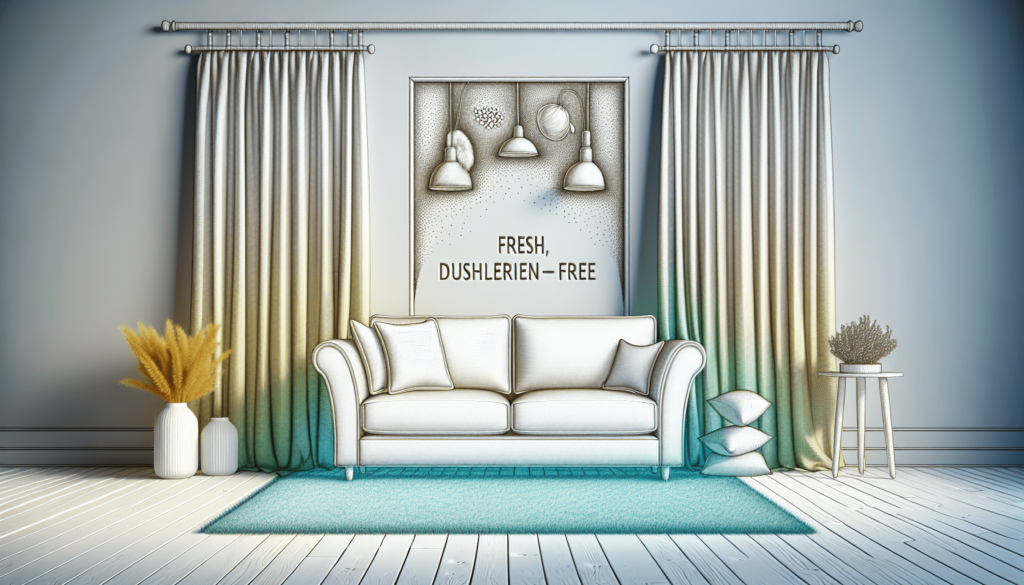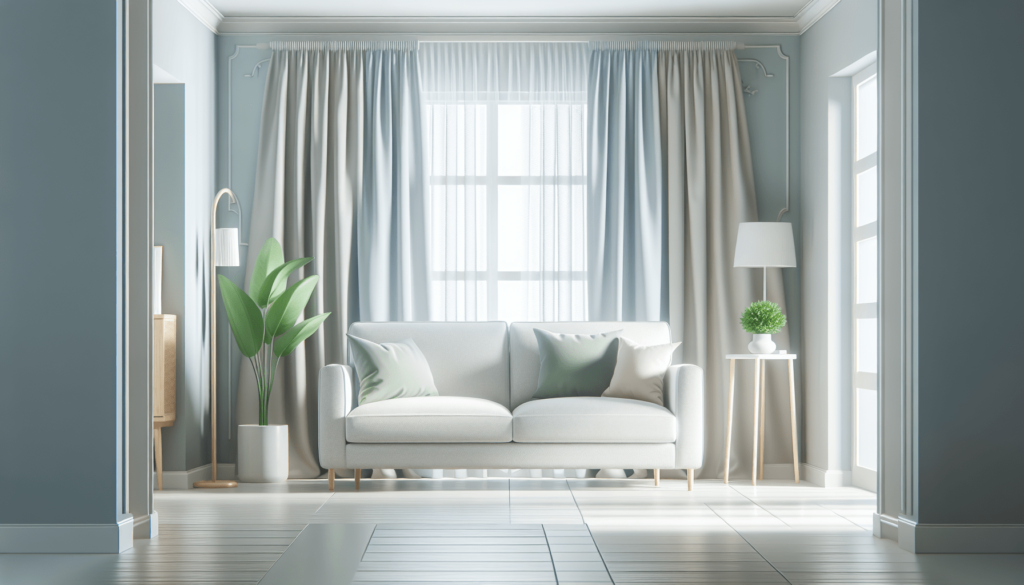Have you ever wondered why you often find yourself sneezing and sniffling, even indoors? It might be the allergens hiding in your upholstery and curtains causing all that discomfort. Managing allergens in your home can be a game-changer for your health, especially if you or a family member suffers from allergies or asthma. Let’s discuss some practical and easy tips to help you reduce allergens in your upholstery and curtains, contributing to a cleaner and healthier home environment.
Understanding Indoor Allergens
Before diving into the tips, it’s essential to know what indoor allergens are and how they affect you. Common indoor allergens include:
Dust Mites
Dust mites are tiny creatures that live in house dust. They thrive in warm, humid environments, making upholstery and curtains their perfect home.
Pet Dander
Pet dander consists of tiny, even microscopic, flecks of skin shed by cats, dogs, rodents, birds, and other animals with fur or feathers.
Pollen
While pollen is typically an outdoor allergen, it can enter your home through open windows and doors, sticking to your clothing, or even your pet’s fur.
Mold Spores
Mold can grow on almost any surface as long as moisture and oxygen are present. Mold spores can aggravate allergies and asthma symptoms.
Household Chemicals
Certain cleaning agents and air fresheners contain chemicals that can trigger allergies.
Regular Cleaning is Key
Regular cleaning helps in removing allergens from your home environment. It’s a proactive approach to keeping allergens at bay.
Vacuuming
Vacuuming can significantly reduce dust mites, pet dander, and other allergens. Use a vacuum with a HEPA filter to ensure it traps even microscopic particles.
- How Often: Aim to vacuum at least twice a week.
- What to Vacuum: Focus on upholstered furniture, curtains, carpets, and rugs.
- Method: Go over each section multiple times to ensure thorough cleaning.
Washing Curtains
Your curtains are another hotspot for allergens. Regular washing can help reduce their presence.
- How Often: Wash curtains every three to four months.
- Method: Use hot water and a hypoallergenic laundry detergent.
- Material Consideration: Check the care label to ensure your curtains can be washed at high temperatures.
Cleaning Upholstery
Cleaning your upholstered furniture helps eliminate allergens and keeps your living space fresh.
- How Often: Clean upholstery every six months.
- What to Use: Use upholstery cleaners suitable for the fabric and a soft-bristle brush.
- Drying: Ensure the furniture dries completely to prevent mold growth.
Professional Cleaning
For a deep clean, consider hiring professionals.
- Frequency: Once a year.
- Benefit: Professionals use advanced techniques and equipment to remove deep-seated allergens.

Practical Measures to Reduce Allergen Buildup
In addition to regular cleaning, there are several practical measures you can take to minimize allergen buildup in your upholstery and curtains.
Using Allergen-Proof Covers
Encasing your furniture with allergen-proof covers helps in creating a barrier between you and the allergens.
- Material: Opt for covers made from tightly-woven fabric.
- Maintenance: Wash these covers regularly.
Choosing Hypoallergenic Materials
When buying new furniture or curtains, consider materials that are less likely to attract and hold allergens.
- Furniture: Leather or vinyl upholstery is easier to clean and doesn’t harbor dust mites.
- Curtains: Choose machine-washable fabrics like cotton or synthetic blends.
Dehumidifying Your Home
Dust mites and mold thrive in humid conditions. Lowering your home’s humidity can deter these allergens.
- Ideal Humidity Level: Keep it between 30%-50%.
- Tools: Use a dehumidifier or air conditioner to maintain the ideal humidity level.
Installing Air Purifiers
Air purifiers with HEPA filters can help remove airborne allergens, improving indoor air quality.
- Placement: Place air purifiers in commonly used rooms, such as the living room and bedroom.
- Maintenance: Regularly replace or clean the air filter as per the manufacturer’s instructions.
Specific Tips for Curtains
Curtains, like upholstery, can quickly become a breeding ground for allergens. Here are some specific tips to keep them in check.
Avoid Heavy Fabrics
Heavy fabrics can trap more dust and allergens compared to lighter materials.
- Recommendation: Use lighter fabrics such as cotton or synthetic blends.
- Ease of Cleaning: Lighter fabrics are easier to take down and wash regularly.
Choosing Machine-Washable Curtains
Machine-washable curtains simplify the cleaning process.
- Ease: You can wash them at home without the need for professional cleaning.
- Frequency: Wash them every three to four months.
Using Roller Blinds or Shades
Consider replacing curtains with roller blinds or shades, which are easier to clean.
- Materials: Choose materials like vinyl or plastic that can be wiped clean.
- Maintenance: Dust and wipe them down regularly.

Specific Tips for Upholstery
Upholstery can act as a magnet for allergens. Follow these specific tips to minimize allergens on your upholstered furniture.
Using Slipcovers
Slipcovers are a practical way to protect your upholstery from allergens.
- Ease of Cleaning: Slipcovers can be removed and washed easily.
- Material Choice: Choose slipcovers made from easily washable fabrics like cotton.
Applying Fabric Treatments
Fabric treatments can reduce allergen buildup on your upholstery.
- Allergen-Reducing Sprays: These sprays can neutralize allergens on fabrics.
- Application: Follow the product’s instructions for application and reapplication.
Regular Grooming of Pets
If you have pets, regular grooming can reduce the amount of pet dander in your home.
- Bathing and Brushing: Regularly bathe and brush your pets to reduce dander.
- Designated Pet Areas: Limit pets to certain areas of the house to contain dander.
Implementing a Routine
Putting these tips into practice is easier when you have a routine. Let’s look at how you can structure your cleaning and maintenance tasks.
Weekly Tasks
Some tasks should be part of your weekly routine.
- Vacuuming: Vacuum upholstery, carpets, and rugs twice a week.
- Dusting: Dust furniture, blinds, and other surfaces.
Monthly Tasks
Certain tasks can be done monthly to keep the allergens under control.
- Washing Slipcovers: Wash slipcovers and cushion covers.
- Cleaning Air Purifiers: Clean or replace air filters.
Quarterly Tasks
Quarterly tasks involve more extensive cleaning efforts.
- Washing Curtains: Take down curtains and wash them.
- Deep Cleaning Upholstery: Use upholstery cleaner for a deep clean.
Annual Tasks
Annual tasks include professional services and thorough cleanups.
- Professional Cleaning: Hire professional cleaners for upholstery and carpets.
- Maintenance Checks: Check and service your air purifiers and dehumidifiers.
Creating an Allergen-Free Zone
While it may be challenging to eliminate all allergens from your home, establishing an allergen-free zone can provide a safe haven, particularly in the bedroom where you spend a significant amount of time.
Bedroom Focus
Making your bedroom an allergen-free zone can significantly improve your sleep quality and overall health.
- Encasing Bedding: Use allergen-proof covers for pillows, mattresses, and box springs.
- Frequent Laundry: Wash bedding in hot water weekly.
Limiting Clutter
Clutter can accumulate dust and allergens, making cleaning more difficult.
- Minimalist Approach: Keep surfaces clear and declutter regularly.
- Storage Solutions: Use closed storage containers to keep items dust-free.
Dealing with Soft Toys
If you have children, their soft toys can also harbor dust mites.
- Regular Washing: Wash soft toys frequently in hot water.
- Freezer Method: Freeze soft toys for 24 hours to kill dust mites, then wash them.
Special Considerations for Allergy Sufferers
If you or someone in your household suffers from severe allergies, additional measures might be necessary.
Allergy Testing
Understanding specific allergens you’re sensitive to can help in better managing your home environment.
- Consult a Doctor: Get an allergy test done to identify triggers.
- Targeted Approach: Focus on reducing identified allergens from your environment.
Allergen-Proof Mattress and Pillow Covers
Using encasements designed to keep allergens at bay can be highly effective.
- Material: Choose high-quality allergen-proof materials.
- Maintenance: Wash and replace them regularly to maintain effectiveness.
Creating Pet-Free Zones
If pet dander is a significant issue, creating pet-free zones can help manage allergens.
- Bedroom Exclusion: Keep pets out of bedrooms to reduce dander in sleeping areas.
- Regular Grooming: Maintain a routine for grooming pets to minimize dander.
Consultation with a Professional
Sometimes, consulting with a professional can offer tailored solutions for severe allergy problems.
- Allergy Specialist: An allergist can offer personalized advice and treatment options.
- Home Inspection: Professionals can identify hidden allergen sources in your home.
Seasonal Adjustments
Allergen levels can vary with the seasons, requiring some adjustments in your cleaning and maintenance routines.
Spring and Summer
During these seasons, pollen, dust mites, and mold tend to be more prevalent.
- Closing Windows: Keep windows closed during high pollen times.
- Using Air Conditioning: Use air conditioning to filter out pollen.
- Regular Washing: Increase the frequency of washing curtains and cleaning upholstery.
Fall and Winter
In colder months, indoor allergens like dust mites and pet dander can be more problematic.
- Using Air Purifiers: Keep air purifiers running to filter indoor air.
- Humidity Control: Monitor and control indoor humidity levels with a dehumidifier.
Long-Term Strategies for Allergen Control
Implementing long-term strategies can help keep allergens at minimal levels and improve your living conditions over time.
Choosing Low-Allergen Home Furnishings
It’s wise to invest in low-allergen furnishings and materials when renovating or redecorating your home.
- Furniture: Opt for easy-to-clean furniture materials like leather or metal.
- Flooring: Consider hard flooring options such as tile, wood, or laminate instead of carpets.
Regular Maintenance Checks
Routine maintenance ensures that your efforts to reduce allergens are sustained.
- HVAC Systems: Regularly clean and maintain your HVAC systems to prevent dust buildup.
- Plumbing: Address any leaks promptly to prevent mold growth.
Educational Resources
Staying informed can help you adapt your cleaning and lifestyle practices to better manage allergens.
- Online Resources: Follow reputable websites and forums dedicated to allergy management.
- Local Workshops: Attend local workshops on allergy prevention and home maintenance.
Conclusion
Reducing allergens in your upholstery and curtains doesn’t have to be an overwhelming task. With regular cleaning, practical measures, and a structured routine, you can significantly improve your home’s air quality. These steps will help create a more comfortable and healthier living environment for you and your family. By understanding and addressing the sources of indoor allergens, you can take control and enjoy a cleaner, allergen-reduced home.
